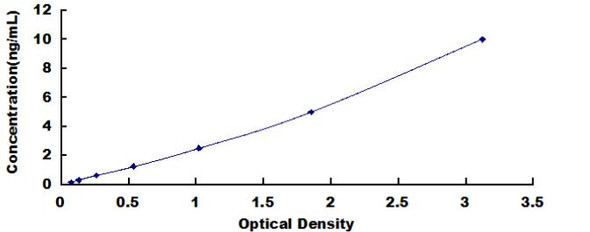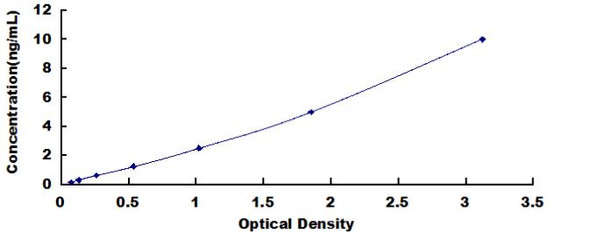Description
Human TSPAN30/CD63 (Tetraspanin 30) ELISA Kit
The Human TSPAN30 (CD63) Tetraspanin-30 ELISA Kit is a powerful tool for detecting levels of TSPAN30 in human serum, plasma, and cell culture supernatants. This kit offers exceptional sensitivity and specificity, ensuring accurate and reproducible results for various research applications.Tetraspanin-30, also known as CD63, is a key protein involved in cell adhesion, migration, and signal transduction. It plays a crucial role in various physiological processes, including immune response, cancer progression, and infectious diseases.
By measuring TSPAN30 levels, researchers can gain valuable insights into the mechanisms underlying these pathways and potentially identify novel therapeutic targets.Overall, the Human TSPAN30 (CD63) Tetraspanin-30 ELISA Kit is a valuable tool for studying the role of TSPAN30 in disease pathology and for developing innovative approaches for diagnosis and treatment.
| Assay type: | Sandwich |
| Format: | 96T |
| Assay time: | 4.5h |
| Reactivity: | Human |
| Detection Method: | Colormetric |
| Detection Range: | 0.16-10 ng/mL |
| Sensitivity: | 0.10 ng/mL |
| Sample Volume Required Per Well: | 100µL |
| Sample Type: | Serum, plasma and other biological fluids |
| Specificity: | This kit recognizes Human TSPAN30/CD63 in samples. No significant cross-reactivity or interference between Human TSPAN30/CD63 and analogues was observed. |
This ELISA kit uses Sandwich-ELISA as the method. The micro ELISA plate provided in this kit has been pre-coated with an antibody specific to Human TSPAN30/CD63. Standards or samples are added to the appropriate micro ELISA plate wells and combined with the specific antibody. Then a biotinylated detection antibody specific for Human TSPAN30/CD63 and Avidin-Horseradish Peroxidase (HRP) conjugate are added to each micro plate well successively and incubated. Free components are washed away. The substrate solution is added to each well. Only those wells that contain Human TSPAN30/CD63, biotinylated detection antibody and Avidin-HRP conjugate will appear blue in color. The enzyme-substrate reaction is terminated by adding Stop Solution and the color turns yellow. The optical density (OD) is measured spectrophotometrically at a wavelength of 450 nm ± 2 nm. The OD value is proportional to the concentration of Human TSPAN30/CD63. The concentration of Human TSPAN30/CD63 in samples can be calculated by comparing the OD of the samples to the standard curve.
| UniProt Protein Function: | Function: This antigen is associated with early stages of melanoma tumor progression. May play a role in growth regulation. |
| UniProt Protein Details: | Subcellular location: Cell membrane; Multi-pass membrane protein. Lysosome membrane; Multi-pass membrane protein. Late endosome membrane; Multi-pass membrane protein. Note: Also found in Weibel-Palade bodies of endothelial cells. Located in platelet dense granules. Ref. 3 Ref. 13 Ref. 15 Ref. 17 Ref. 18 Tissue specificity: Dysplastic nevi, radial growth phase primary melanomas, hematopoietic cells, tissue macrophages. Miscellaneous: Lack of expression of CD63 in platelets has been observed in a patient with Hermansky-Pudlak syndrome (HPS). Hermansky-Pudlak syndrome (HPS) is a genetically heterogeneous, rare, autosomal recessive disorder characterized by oculocutaneous albinism, bleeding due to platelet storage pool deficiency, and lysosomal storage defects. This syndrome results from defects of diverse cytoplasmic organelles including melanosomes, platelet dense granules and lysosomes. Ceroid storage in the lungs is associated with pulmonary fibrosis, a common cause of premature death in individuals with HPS. Sequence similarities: Belongs to the tetraspanin (TM4SF) family. |
| NCBI Summary: | The protein encoded by this gene is a member of the transmembrane 4 superfamily, also known as the tetraspanin family. Most of these members are cell-surface proteins that are characterized by the presence of four hydrophobic domains. The proteins mediate signal transduction events that play a role in the regulation of cell development, activation, growth and motility. The encoded protein is a cell surface glycoprotein that is known to complex with integrins. It may function as a blood platelet activation marker. Deficiency of this protein is associated with Hermansky-Pudlak syndrome. Also this gene has been associated with tumor progression. Alternative splicing results in multiple transcript variants encoding different protein isoforms. [provided by RefSeq, Apr 2012] |
| UniProt Code: | P08962 |
| NCBI GenInfo Identifier: | 383872547 |
| NCBI Gene ID: | 967 |
| NCBI Accession: | NP_001244330. 1 |
| UniProt Secondary Accession: | P08962,Q5TZP3, Q8N6Z9, Q9UCG6, F8VZE2, |
| UniProt Related Accession: | P08962 |
| Molecular Weight: | |
| NCBI Full Name: | CD63 antigen isoform D |
| NCBI Synonym Full Names: | CD63 molecule |
| NCBI Official Symbol: | CD63 |
| NCBI Official Synonym Symbols: | MLA1; ME491; LAMP-3; OMA81H; TSPAN30 |
| NCBI Protein Information: | CD63 antigen; tspan-30; granulophysin; tetraspanin-30; melanoma-associated antigen MLA1; CD63 antigen (melanoma 1 antigen); melanoma-associated antigen ME491; ocular melanoma-associated antigen; lysosomal-associated membrane protein 3; lysosome-associated membrane glycoprotein 3 |
| UniProt Protein Name: | CD63 antigen |
| UniProt Synonym Protein Names: | Granulophysin; Lysosomal-associated membrane protein 3; LAMP-3; Melanoma-associated antigen ME491; OMA81H; Ocular melanoma-associated antigen; Tetraspanin-30 |
| Protein Family: | CD63 antigen |
| UniProt Gene Name: | CD63 |
| UniProt Entry Name: | CD63_HUMAN |
As the OD values of the standard curve may vary according to the conditions of the actual assay performance (e. g. operator, pipetting technique, washing technique or temperature effects), the operator should establish a standard curve for each test. Typical standard curve and data is provided below for reference only.
| Concentration (ng/mL) | O.D | Average | Corrected |
| 10 | 2.249 2.255 | 2.252 | 2.163 |
| 5 | 1.422 1.464 | 1.443 | 1.354 |
| 2.5 | 0.854 0.844 | 0.849 | 0.76 |
| 1.25 | 0.481 0.485 | 0.483 | 0.394 |
| 0.63 | 0.288 0.258 | 0.273 | 0.184 |
| 0.32 | 0.193 0.167 | 0.18 | 0.091 |
| 0.16 | 0.128 0.146 | 0.137 | 0.048 |
| 0 | 0.084 0.094 | 0.089 | -- |
Precision
Intra-assay Precision (Precision within an assay): 3 samples with low, mid range and high level Human TSPAN30/CD63 were tested 20 times on one plate, respectively.
Inter-assay Precision (Precision between assays): 3 samples with low, mid range and high level Human TSPAN30/CD63 were tested on 3 different plates, 20 replicates in each plate.
| Intra-assay Precision | Inter-assay Precision | |||||
| Sample | 1 | 2 | 3 | 1 | 2 | 3 |
| n | 20 | 20 | 20 | 20 | 20 | 20 |
| Mean (ng/mL) | 0.54 | 0.92 | 4.69 | 0.57 | 0.94 | 4.69 |
| Standard deviation | 0.03 | 0.05 | 0.19 | 0.04 | 0.04 | 0.18 |
| C V (%) | 5.56 | 5.43 | 4.05 | 7.02 | 4.26 | 3.84 |
Recovery
The recovery of Human TSPAN30/CD63 spiked at three different levels in samples throughout the range of the assay was evaluated in various matrices.
| Sample Type | Range (%) | Average Recovery (%) |
| Serum (n=5) | 90-102 | 96 |
| EDTA plasma (n=5) | 85-95 | 90 |
| Cell culture media (n=5) | 93-110 | 101 |
Linearity
Samples were spiked with high concentrations of Human TSPAN30/CD63 and diluted with Reference Standard & Sample Diluent to produce samples with values within the range of the assay.
| Serum (n=5) | EDTA plasma (n=5) | Cell culture media (n=5) | ||
| 1:2 | Range (%) | 93-108 | 93-107 | 96-109 |
| Average (%) | 101 | 99 | 103 | |
| 1:4 | Range (%) | 94-107 | 81-93 | 83-93 |
| Average (%) | 99 | 87 | 88 | |
| 1:8 | Range (%) | 90-101 | 84-98 | 84-97 |
| Average (%) | 96 | 91 | 91 | |
| 1:16 | Range (%) | 86-98 | 82-97 | 83-95 |
| Average (%) | 93 | 88 | 88 |
An unopened kit can be stored at 4°C for 1 month. If the kit is not used within 1 month, store the items separately according to the following conditions once the kit is received.
| Item | Specifications | Storage |
| Micro ELISA Plate(Dismountable) | 8 wells ×12 strips | -20°C, 6 months |
| Reference Standard | 2 vials | |
| Concentrated Biotinylated Detection Ab (100×) | 1 vial, 120 µL | |
| Concentrated HRP Conjugate (100×) | 1 vial, 120 µL | -20°C(shading light), 6 months |
| Reference Standard & Sample Diluent | 1 vial, 20 mL | 4°C, 6 months |
| Biotinylated Detection Ab Diluent | 1 vial, 14 mL | |
| HRP Conjugate Diluent | 1 vial, 14 mL | |
| Concentrated Wash Buffer (25×) | 1 vial, 30 mL | |
| Substrate Reagent | 1 vial, 10 mL | 4°C(shading light) |
| Stop Solution | 1 vial, 10 mL | 4°C |
| Plate Sealer | 5 pieces | |
| Product Description | 1 copy | |
| Certificate of Analysis | 1 copy |
- Set standard, test sample and control (zero) wells on the pre-coated plate and record theirpositions. It is recommended to measure each standard and sample in duplicate. Note: addall solutions to the bottom of the plate wells while avoiding contact with the well walls. Ensuresolutions do not foam when adding to the wells.
- Aliquot 100µl of standard solutions into the standard wells.
- Add 100µl of Sample / Standard dilution buffer into the control (zero) well.
- Add 100µl of properly diluted sample (serum, plasma, tissue homogenates and otherbiological fluids) into test sample wells.
- Cover the plate with the sealer provided in the kit and incubate for 90 min at 37°C.
- Aspirate the liquid from each well, do not wash. Immediately add 100µL of BiotinylatedDetection Ab working solution to each well. Cover the plate with a plate seal and gently mix. Incubate for 1 hour at 37°C.
- Aspirate or decant the solution from the plate and add 350µL of wash buffer to each welland incubate for 1-2 minutes at room temperature. Aspirate the solution from each well andclap the plate on absorbent filter paper to dry. Repeat this process 3 times. Note: a microplatewasher can be used in this step and other wash steps.
- Add 100µL of HRP Conjugate working solution to each well. Cover with a plate seal andincubate for 30 min at 37°C.
- Aspirate or decant the solution from each well. Repeat the wash process for five times asconducted in step 7.
- Add 90µL of Substrate Reagent to each well. Cover with a new plate seal and incubate forapproximately 15 min at 37°C. Protect the plate from light. Note: the reaction time can beshortened or extended according to the actual color change, but not by more than 30min.
- Add 50 µL of Stop Solution to each well. Note: Adding the stop solution should be done inthe same order as the substrate solution.
- Determine the optical density (OD value) of each well immediately with a microplate readerset at 450 nm.







